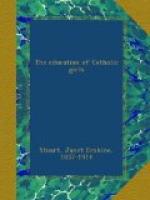Probably for girls the strongest argument against experimental science taught in laboratories is that it has so little connexion with after life. As a discipline the remedy did not go deeply enough into the realities of life to reach the mental defects of girls; it was artificial, and they laid it aside as a part of school life when they went home. Latitude is now given by the Board of Education for “an approved course in a combination of the following subjects: needlework, cooking, laundry-work, housekeeping, and household hygiene for girls over fifteen years of age, to be substituted partially or wholly for science and for mathematics other than arithmetic.” Comparing this with the regulations of five or six years ago when the only alternative for girls was a “biological subject” instead of physics, and elementary hygiene as a substitute for chemistry, it would seem as if the Board of Education had had reason to be dissatisfied with the “science” teaching for girls, and was determined to seek a more practical system.
This practical aspect of things is penetrating into every department, and when it is combined with some study of first principles nothing better can be desired. For instance, in the teaching of geography, of botany, etc., there is a growing inclination to follow the line of reality, the middle course between the book alone and the laboratory alone, so that these subjects gather living interest from their many points of contact with human life, and give more play to the powers of children. As the text-book of geography is more and more superseded by the use of the atlas alone, and the botanical chart by the children’s own drawings, and by the beautiful illustrations in books prepared especially for them, the way is opened before them to worlds of beauty and wonder which they may have for their own possession by the use of their eyes and ears and thoughts and reasonings.




